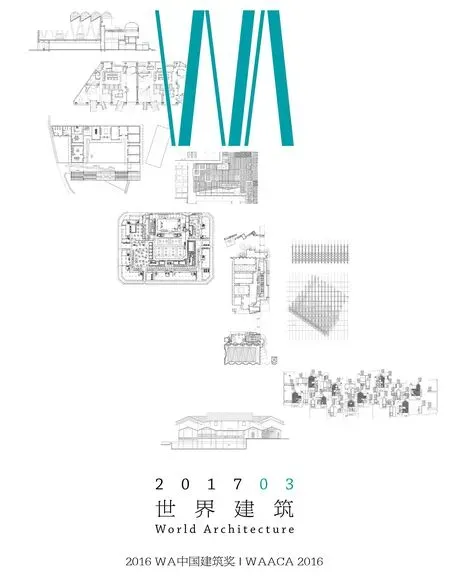枓栱之方,北京,中国
建筑设计:何珅,吴朝赟,程昆/清华大学建筑学院
枓栱之方,北京,中国
建筑设计:何珅,吴朝赟,程昆/清华大学建筑学院

1.2 外景/Exterior views3 斗拱局部/Brackets detail

4 场地剖面/Site section
枓栱之方是五年级学生吴朝赟、何珅和程昆在柯瑞教授的指导下完成的毕业设计,三位学生共同为该项目连续工作11个月。在这一研究驱动型设计中,他们体验了探索研究、寻求资金支持、概念设计、完善并测试设计方案,然后制作、装配和安装,从而最终实现设计。
三位学生的课题为:工具与制作的关系(吴朝赟),木材性质与木制品连接(何珅),预制化与装配系统(程昆)。课题作为框架,为项目提供了切入点,而建筑学院副院长则提出了新馆中庭“沙龙”的想法。枓栱的概念在多次探索中产生。尺度、开口、座椅与柜体整合与平立剖面受到功能、技术、规范和预算以及诠释宋式枓栱、主要材料多层板与科技木的影响。
最终设计包含超过2400片独立枓栱构件,120种不同的截面形状,榫卯门板,定制五金件,集成电力照明,视听系统及滑动玻璃门。设计、加工图、生产、上漆和组装均由学生自主完成。为实现高精度装配,学生们制作了超过100个夹具。为确保形式简洁并清晰地表达枓栱结构,管线,玻璃门悬挂方式,以及电源插座、开关与照明设备等位置都必须在设计初期就要纳入考虑。
学生在有限的时间、资源、经验和工业质量的设备和工具下实现的优雅设计与精致工艺是非常卓越的。这是一项誓约,展示了他们对工艺的热爱、决心、努力工作程度和对项目最终愿景的清晰认知。□
The Cube of Brackets Meeting Room is the graduation thesis project of WU Chaoyun, HE Shen and CHENG Kun with the help and supervision of professor Terrence Curry. They worked together over 11 months in this research driven design project, through which they could explore their research, found funding, conceptualized, refined, and tested a design solution; then fabricated, assembled and installed their design.
The students' research topics included: the relationship between tools and fabrication (WU Chaoyun) ; the properties of wood, wood products and wood joints (HE Shen) ; prefabrication and assembly systems (CHENG Kun). These topics provided the lens while the opportunity was presented to the students by the associate dean: a "salon". After exploring multiple concepts, Dougong (bracket set) emerged through discussion and exploration as a means to integrate the students research interests. The overall size, openings, integration of benches and cabinetry, plan, elevation and section were infuenced by functional, technical, legal and budgetary requirements; as well as the specifc conditions created by the choice to base the design on a contemporary interpretation of Song era bracket sets and the use of plywood and engineered wood products as the primary building materials.
The fnal design included over 2400 individual bracket pieces, 120 different profiles, traditionally joined door panels, custom design hardware, an integrated electrical, light and audio/visual system, as well as sliding glass doors. All of the design, shop drawings, fabrication, finishing and installation were completed by the students. In these kinds of design/building projects, it is always necessary to allow for mistakes and adaptation. The complexity of the assembly did not allow for much tolerance. To compensate for this, the students made over 100 jigs to insure the necessary level of accuracy. To retain the cleanness of the form, and the clear expression of the bracket sets, it was necessary to anticipate where the conduit would run, how the glass doors would be hung, the location of electrical outlets, switches, light fxtures, etc. as these all needed to be integrated into the primary elements.
The elegant design and level of craftsmanship that the students were able to achieve with limited time, resources, experience and access to industrial quality equipment and tools are truly remarkable. It is a testament to their love of craft, determination, hard work and a clear vision of what the fnal design would be.□

5 外景/Exterior view

6 仰视内景/Upward view

7 夜景/Night view

8 夜景/Night view

9 设计过程/Design process

10.11 剖面/Sections
项目信息/Credits and Data
客户/Client: 清华大学建筑学院/School of Architecture, Tsinghua University
地点/Location: 清华大学建筑学院新馆中庭/Atrium of new building in School of Architecture, Tsinghua University
指导老师/Supervisor: 柯瑞/Terrence Curry
设计团队/Project Team: 何珅,吴朝赟,程昆/HE Shen, WU Chaoyun, CHENG Kun
建筑面积/Floor Area: 20m2
设计时间/Design Period: 2014.11-2015.05
建成时间/Completion Time: 2015.07
摄影/Photos: Eric Powell (fig.1,2,5,6,8),刘楚婷/LIU Chuting (fg.3),何珅/HE Shen (fg.7,12)
评委评语
这是在传统教学科研空间内设置的一个具有实验性的空间装置。设计将“亭”置于建筑二层的中庭中央,通过中庭空间自下而上地与建筑的所有公共空间相联系,兼顾采光与通风。它成为了建筑学院新馆室内空间思考的重点,从不同的角度诠释空间与内容的关系,同时又围绕建筑馆空间整体展开,使建筑内部的每一个角落都可以感受到这个中心。带有中式斗拱意象的精致的木构装置,相互穿插形成空间中的围合与限定,完美展现了建构逻辑。□
Jury Statement
The "pavilion" is an experimental space situated in the traditional teaching and research setting of a university. Installed in the center of the second foor atrium of the New Building at Tsinghua's School of Architecture, it is connected with the upper stories through a shaft-like atrium, taking into account lighting and ventilation. Walking around the installation or ascending the individual stories of the New Building allows for diferent interpretations of the cubic space and what is contained therein. But the cube also forms a functional entity with its surrounding environment, providing a new spatial center that is felt from every corner of the New Building. Assembled from hundreds of brackets that intertwine with each other and surround and demarcate the empty space in their midst, the delicate wooden construct beautifully illustrates the Chinese logic of construction.□
Cube of Brackets, Beijing, China, 2015
Architects: HE Shen, WU Chaoyun, CHENG Kun/School of Architecture, Tsinghua University

12 斗拱局部/Brackets detail

13 枓栱分件图/Piece drawing

